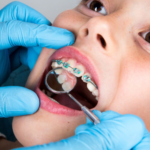Invisalign provides teens and adults alike an unobtrusive alternative to traditional braces, without the food restrictions imposed by wires and brackets – including apples, carrots, popcorn, chips and candy!

Invisalign can correct issues related to crowding, crookedness, overbites, underbites and tooth gaps as well as jaw issues such as crossbites or open bites.
What Is Invisalign?
If you want a straighter smile without metal wires and brackets, Invisalign could be the right solution for you. Using BPA-free thermoplastic trays that slowly shift teeth over time, Invisalign provides a discreet method of straightening them for improved confidence and smiles.
Beginning the process with an initial consultation appointment, dentists evaluate patients to make sure that they are suitable candidates for Invisalign. At this visit, X-rays and digital scans of your mouth are taken and uploaded into an specialized software system which creates 3D mockups of how your teeth may appear over time. Once this information is ready to go, your dentist will forward it off to an Invisalign lab which will fabricate custom trays specifically made to fit you.
Your Invisalign treatment duration depends on how faithfully you adhere to its regimen; optimal performance requires wearing your trays for 20-22 hours per day in order to achieve maximum effectiveness of this form of orthodontic care.
Clean your trays regularly before and after brushing to help avoid smelly trays due to bacteria buildup. For an additional freshening effect, soak your trays overnight in a cleanser tablet available from most health stores – this should keep them smelling nicer longer!
How Does Invisalign Work?
Invisalign is a clear aligner system designed to slowly but gradually move teeth into their desired positions. Patients can easily remove Invisalign trays for eating, drinking (excluding water), brushing teeth and flossing routines and general oral health maintenance routines.
These aligners are made from BPA-free plastic and tailored specifically for each patient, so that they blend in more discreetly than traditional metal braces do. Clear aligners have become popular choices among teens and adults who don’t wish to deal with metal wires, brackets and elastic bands associated with standard orthodontic treatments.
Just as with any dental treatment, successful Invisalign results depend on a patient’s dedication and determination. Patients must wear their Invisalign trays for at least 22 hours per day and should only remove them to brush and floss their teeth as well as attend special events and social occasions; failing to comply may mean lengthening Invisalign treatment timeframe.
One important thing to keep in mind when wearing Invisalign is that some foods may become stuck under its trays, so patients should strive to consume a diet consisting of lean proteins, fruits, vegetables and whole grains throughout their treatment period. Brushing and flossing at least twice per day after every meal or snack should also help.
Are Invisalign Aligners Right for Me?
By opting for Invisalign, you’re choosing an easy and discreet method of straightening your teeth. This orthodontic treatment can effectively address many different issues such as overbites, underbites, crossbites, crookedness or gaps or overlapped teeth.
Due to how Invisalign works, it requires your full commitment and participation during treatment. Wear your trays for about 22 hours every day (removing when eating/drinking), returning for regular follow up appointments with Kirkland orthodontist and wearing aligners correctly – otherwise it could take much longer before seeing results! If this is a concern for you, wear aligners correctly as this could hinder results faster and take longer for you.
If your case is more complex than average, special attachments or buttons may also be required to help speed up Invisalign treatment. They’re made out of similar-colored materials to blend seamlessly with your smile; simply gluing them to the surface of your teeth will do. When used strategically they should help your treatment proceed more quickly.
Keep in mind that Invisalign will not work for every individual; while most cases of crookedness can be addressed by this treatment, not all types of bites or tooth irregularities will respond well. To determine whether Invisalign would work for you, we advise scheduling a consultation appointment with either your dentist or orthodontist in order to discuss their individual needs and goals for treatment.
Are Invisalign Aligners Right for You?
While Invisalign can effectively treat overcrowding, gaps between teeth, and crossbite, it may not be appropriate for everyone. It works best on patients who can adhere to wearing their aligners for 22 hours every day; otherwise results could be delayed and worsened by doing otherwise. Furthermore, failure to take proper precautions when eating and drinking anything other than water may damage them quickly requiring replacement immediately.
However, Invisalign may not be the optimal treatment option for adults suffering from more complex issues like overbites and underbites that require traditional metal braces to correct. It remains an attractive alternative for many adult patients who want a straighten their smile without the stigma of train track-style braces.
One important point to keep in mind when using Invisalign is that it may take some time to adjust to speaking with it in place. Some patients have reported feeling like they have a lisp or different voice for several weeks after starting, though others should notice little of any effect; eventually this should resolve itself on its own. Also remember to clean Invisalign trays regularly just like your teeth do for optimal performance.






